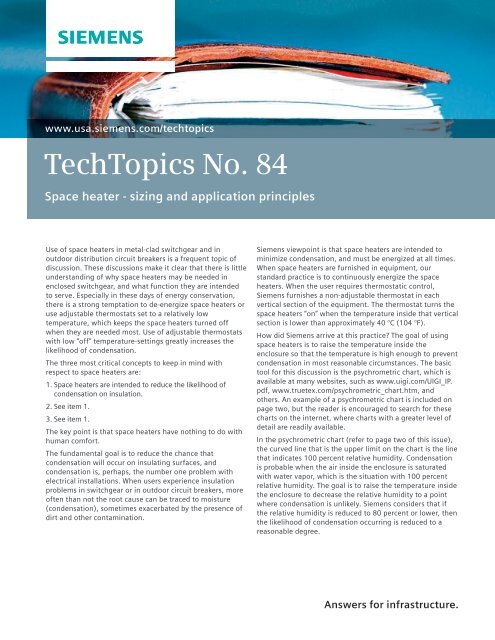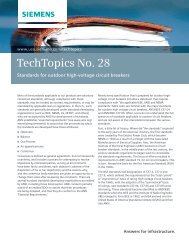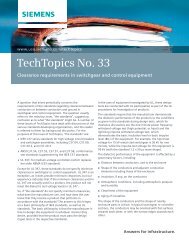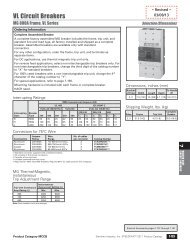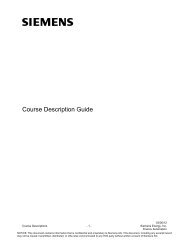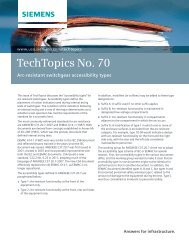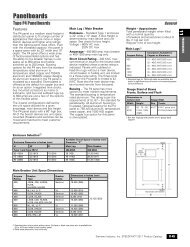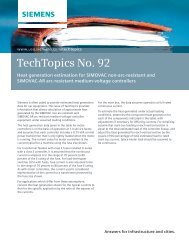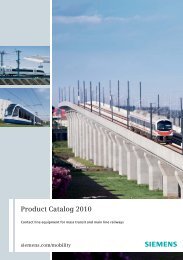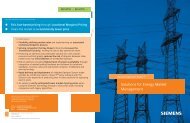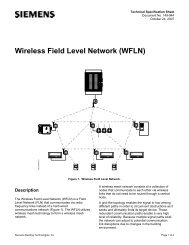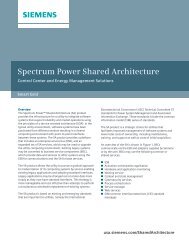Space heater - sizing and application principles - Siemens
Space heater - sizing and application principles - Siemens
Space heater - sizing and application principles - Siemens
Create successful ePaper yourself
Turn your PDF publications into a flip-book with our unique Google optimized e-Paper software.
www.usa.siemens.com/techtopicsTechTopics No. 84<strong>Space</strong> <strong>heater</strong> - <strong>sizing</strong> <strong>and</strong> <strong>application</strong> <strong>principles</strong>Use of space <strong>heater</strong>s in metal-clad switchgear <strong>and</strong> inoutdoor distribution circuit breakers is a frequent topic ofdiscussion. These discussions make it clear that there is littleunderst<strong>and</strong>ing of why space <strong>heater</strong>s may be needed inenclosed switchgear, <strong>and</strong> what function they are intendedto serve. Especially in these days of energy conservation,there is a strong temptation to de-energize space <strong>heater</strong>s oruse adjustable thermostats set to a relatively lowtemperature, which keeps the space <strong>heater</strong>s turned offwhen they are needed most. Use of adjustable thermostatswith low “off” temperature-settings greatly increases thelikelihood of condensation.The three most critical concepts to keep in mind withrespect to space <strong>heater</strong>s are:1. <strong>Space</strong> <strong>heater</strong>s are intended to reduce the likelihood ofcondensation on insulation.2. See item 1.3. See item 1.The key point is that space <strong>heater</strong>s have nothing to do withhuman comfort.The fundamental goal is to reduce the chance thatcondensation will occur on insulating surfaces, <strong>and</strong>condensation is, perhaps, the number one problem withelectrical installations. When users experience insulationproblems in switchgear or in outdoor circuit breakers, moreoften than not the root cause can be traced to moisture(condensation), sometimes exacerbated by the presence ofdirt <strong>and</strong> other contamination.<strong>Siemens</strong> viewpoint is that space <strong>heater</strong>s are intended tominimize condensation, <strong>and</strong> must be energized at all times.When space <strong>heater</strong>s are furnished in equipment, ourst<strong>and</strong>ard practice is to continuously energize the space<strong>heater</strong>s. When the user requires thermostatic control,<strong>Siemens</strong> furnishes a non-adjustable thermostat in eachvertical section of the equipment. The thermostat turns thespace <strong>heater</strong>s “on” when the temperature inside that verticalsection is lower than approximately 40 °C (104 °F).How did <strong>Siemens</strong> arrive at this practice? The goal of usingspace <strong>heater</strong>s is to raise the temperature inside theenclosure so that the temperature is high enough to preventcondensation in most reasonable circumstances. The basictool for this discussion is the psychrometric chart, which isavailable at many websites, such as www.uigi.com/UIGI_IP.pdf, www.truetex.com/psychrometric_chart.htm, <strong>and</strong>others. An example of a psychrometric chart is included onpage two, but the reader is encouraged to search for thesecharts on the internet, where charts with a greater level ofdetail are readily available.In the psychrometric chart (refer to page two of this issue),the curved line that is the upper limit on the chart is the linethat indicates 100 percent relative humidity. Condensationis probable when the air inside the enclosure is saturatedwith water vapor, which is the situation with 100 percentrelative humidity. The goal is to raise the temperature insidethe enclosure to decrease the relative humidity to a pointwhere condensation is unlikely. <strong>Siemens</strong> considers that ifthe relative humidity is reduced to 80 percent or lower, thenthe likelihood of condensation occurring is reduced to areasonable degree.Answers for infrastructure.
21Psychrometric Chart5.2 °F(2.9 °C)I-28Engineering6.3 °F(3.5 °C)1. Relative humidity 80%2. Relative humidity 100%www.usa.siemens.com/hvacAgain, looking at the psychrometric chart, consider anexample of a temperature of 32 °F (0 °C) <strong>and</strong> 100 percentrelative humidity. To reduce the relative humidity to 80percent, the temperature inside the enclosure would have tobe increased by 5.2 °F (2.9 °C), as shown by the lines plottedon the chart.For a second example, consider a temperature of 77 °F(25 °C) <strong>and</strong> 100 percent relative humidity. To reduce to 80percent relative humidity would require an increase in thetemperature inside the enclosure of 6.3 °F (3.5 °C).Two conclusions arise from these examples. First, only amoderate increase in temperature is needed to reduce thelikelihood of condensation occurring. Second, the absolutetemperature is irrelevant. If the relative humidity is 100percent inside the enclosure, regardless of the temperatureinside the enclosure, supplemental heating is needed todrive the relative humidity down to a reasonable value, orthere will be a strong likelihood of condensation. It is thislast point that leads to our conclusion that space <strong>heater</strong>smust be energized at all times to minimize the likelihood ofcondensation occurring.All of this assumes the worst case, in which the equipmentis not carrying substantial current. In olden days, someengineers argued that if the equipment were energized, thelosses in the equipment would be sufficient to preventcondensation. The reality is that, in many cases, this is valid.However, in many cases, it is not valid.A very simple example will illustrate the dilemma. Supposethere is a 1,200 A circuit breaker unit, <strong>and</strong> suppose that thisunit is carrying 200 A.If the circuit breaker unit meets the ANSI/IEEE C37.20.2limits on temperature rise, the highest temperature rise at1,200 A would be 65 °C. In many instances, it would belower, but we can use 65 °C for this discussion.What would the highest temperature rise of the buses <strong>and</strong>connections in this example unit be with a current of 200 Ainstead of 1,200 A? Heating is a function of the square ofthe current <strong>and</strong> the resistance. For a given unit, resistance isconstant, so the temperature rise of the 1,200 A unit at200 A actual current would be (200 2 /1,200 2 ) x 65 °C =1.8 °C (3.2 °F).
Also, this level of temperature rise in the conductors wouldbe considerably higher than the resulting increase intemperature of the air inside the enclosure. From thepsychrometric chart calculations performed earlier, thiswould not be sufficient to reduce the likelihood ofcondensation to the extent that <strong>Siemens</strong> would feelcomfortable with.The example above assumes a modest current of 200 A,one-sixth of the circuit breaker rating for this example. Itshould be clear that the situation is more severe in the caseof a circuit that is not carrying current, such as for anormally-open tie circuit breaker, where the heat generatedduring normal operation is essentially none.From the examples discussed, a rule-of-thumb was selectedthat the air temperature inside the enclosure should beraised about 4 °C (7.2 °F) in order to have reasonableconfidence that the relative humidity will be reduced to80 percent, <strong>and</strong> the risk of condensation mitigated.From this discussion, one can underst<strong>and</strong> why <strong>Siemens</strong>position is that space <strong>heater</strong>s should be energized at alltimes. The exception to this would be when the load beingcarried in the unit is high enough to produce significantheating of the air in the enclosure so as to reduce therelative humidity to 80 percent or less. This level oftemperature rise on bus <strong>and</strong> connections is likely to besignificantly higher than just 4 °C, as all of the heat in thebus bars would not convert into heating of the air in theenclosure.<strong>Siemens</strong> often receives requests for adjustable thermostatsfrom users. We speculate that the desire for an adjustablethermostat comes from confusion between personnelcomfort <strong>and</strong> the need to minimize condensation. The use ofan adjustable thermostat is an invitation for the user toreduce the thermostat setting to save energy, in the process,significantly increasing the likelihood of condensation. Asthe likelihood of condensation increases, so also does thelikelihood of ultimate catastrophic failure due tocondensation.<strong>Siemens</strong> practices <strong>and</strong> recommendations are:<strong>Space</strong> <strong>heater</strong>s are a highly recommended option for anyinstallation, especially any <strong>application</strong> where thelikelihood of condensation is relative high. <strong>Space</strong> <strong>heater</strong>sare a st<strong>and</strong>ard component of any outdoor switchgear oroutdoor circuit breakers that we supply.As st<strong>and</strong>ard, we prefer to continuously energize space<strong>heater</strong>s, <strong>and</strong> no thermostat is provided.When thermostatic control is required, a non-adjustablethermostat should be used in each vertical section. Ourst<strong>and</strong>ard thermostat is selected to open at 110 °F +/- 5 °F<strong>and</strong> close at 100 °F +/- 5 °C temperature inside theenclosure. This keeps the space <strong>heater</strong>s “on” at all timesunless the temperature inside the enclosure exceeds110 °F +/- 5 °C.If adjustable thermostats are used, they should be set tokeep the space <strong>heater</strong>s “on” in line with the values givenabove for our non-adjustable thermostat.A single thermostat for an entire lineup should not beused. The amount of heat generated by current in eachvertical section differs, <strong>and</strong> space heating may be neededin some vertical sections, but not in others.The need for heat to minimize condensation is higher athigher temperatures than it is for lower temperatures. Inthe 32 °F (0 °C) example, a temperature increase of 2.9 °Cis needed to bring relative humidity down to 80 percent,whereas at 25 °C, an increase of 3.5 °C is needed.This discussion does not deal with the need to reduce thelikelihood of condensation in low-voltage compartments(for example, in control <strong>and</strong> protective relay compartments).The focus of this discussion is on the high-voltagecomponents.<strong>Space</strong> <strong>heater</strong>s are often not specified for use in indoorswitchgear, as indoor switchgear is often in a climatecontrolled area in which the relative humidity is maintainedat levels at which condensation is unlikely to occur.One last observation before this discussion is closed. Thepossibility always exists that the rate of change of outsidetemperature <strong>and</strong> humidity can exceed the rate at which theequipment can respond in reducing relative humidity insidethe enclosure. In such instances, condensation can occur.The object of using space <strong>heater</strong>s is to reduce the likelihoodof condensation occurring, but no system can fully eliminatethe possibility.The information provided in this document contains merely generaldescriptions or characteristics of performance which in case of actualuse do not always apply as described or which may change as a result offurther development of the products. An obligation to provide therespective characteristics shall only exist if expressly agreed in the termsof contract.All product designations may be trademarks or product names of<strong>Siemens</strong> AG or supplier companies whose use by third parties for theirown purposes could violate the rights of the owners.<strong>Siemens</strong> Industry, Inc.7000 <strong>Siemens</strong> RoadWendell, NC 27591Subject to change without prior notice.Order No.: E50001-F710-A460-V1-4A00All rights reserved.© 2012 <strong>Siemens</strong> Industry, Inc.For more information, contact: +1 (800) 347-6659www.usa.siemens.com/techtopics


